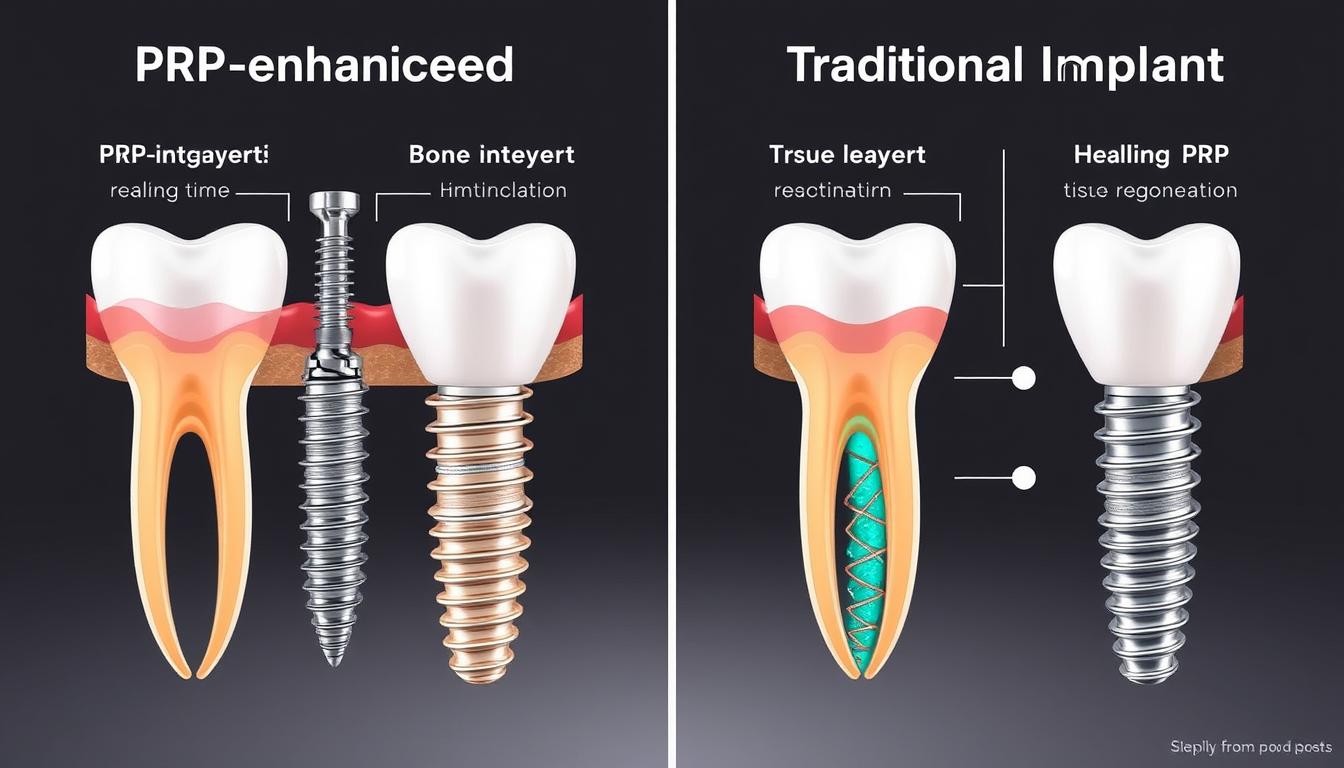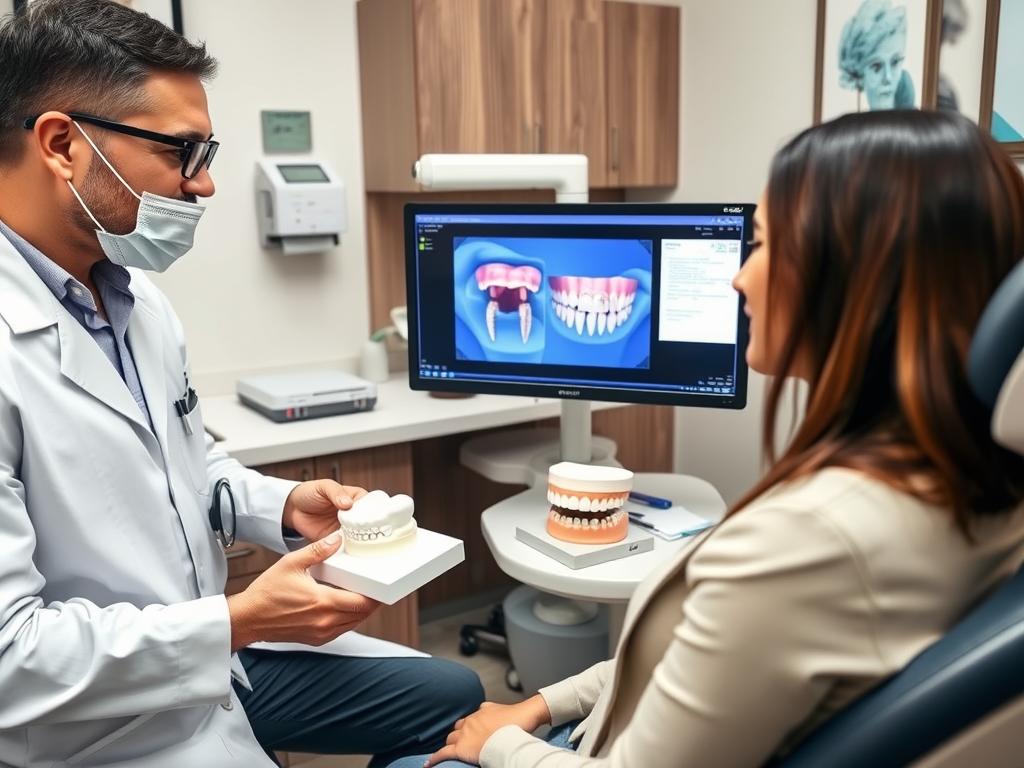Dental implant success depends on proper healing and integration with your jawbone. While traditional implant procedures have good success rates, innovative approaches like Platelet-Rich Plasma (PRP) therapy are revolutionizing the field by enhancing the healing process and improving outcomes. This advanced technique uses your body’s natural healing properties to create stronger, more successful dental implants with faster recovery times.
If you’re considering dental implants or have been told you lack sufficient bone density, PRP treatment might be the solution you’ve been looking for. Let’s explore how this cutting-edge therapy works and why it’s becoming increasingly popular in implant dentistry.
What is Platelet-Rich Plasma (PRP) Treatment?

Platelet-Rich Plasma (PRP) is a concentrated solution derived from your own blood that contains an elevated level of platelets, growth factors, and cytokines. These components play a crucial role in tissue healing and regeneration. The concentration of platelets in PRP can be up to five times higher than what’s found in normal blood.
Platelets are tiny blood cells that are primarily known for their role in clotting, but they also release growth factors that stimulate cell reproduction and tissue regeneration. When applied to a dental implant site, these growth factors accelerate healing and promote stronger integration between the implant and your jawbone. PRF Treatment for Dental Implants: Benefits, Procedure, and Recovery
How PRP is Prepared
The PRP preparation process is straightforward and can be performed right in your dentist’s office:
- A small amount of blood (similar to a standard blood test) is drawn from your arm
- The blood sample is placed in a centrifuge machine that spins at high speed
- This spinning process separates the blood into its components: red blood cells, plasma, and platelets
- The platelet-rich portion is extracted and prepared for application
- The concentrated PRP is then applied directly to the implant site during surgery
Since PRP is derived from your own blood, there’s virtually no risk of allergic reaction or rejection, making it an exceptionally safe treatment option for most patients.
Benefits of PRP Treatment for Dental Implants

The application of PRP during dental implant procedures offers numerous advantages that can significantly improve outcomes and patient experience. Research continues to demonstrate its effectiveness in enhancing the implant process.
Accelerated Healing
One of the most significant benefits of PRP treatment for dental implants is the dramatically reduced healing time. A 2021 study in the Journal of Oral Implantology found that patients receiving PRP therapy experienced up to 50% faster healing compared to traditional implant procedures.
This accelerated healing means you can progress through the implant stages more quickly and enjoy your new smile sooner. The typical dental implant process can take 5-8 months, but with PRP, many patients see substantial reductions in this timeline.
Enhanced Bone Regeneration
PRP contains growth factors that stimulate bone-forming cells (osteoblasts), encouraging faster and more robust bone growth around the implant. This process, known as osseointegration, is crucial for implant stability and long-term success.
A 2022 clinical study published in the International Journal of Implant Dentistry reported that implant sites treated with PRP showed 40% greater bone density after three months compared to control sites without PRP treatment.
Reduced Inflammation and Pain
The anti-inflammatory properties of PRP help minimize post-operative swelling and discomfort. Patients typically report less pain and require fewer pain medications following PRP-enhanced implant procedures.
Lower Risk of Complications
By promoting faster tissue regeneration and creating a protective barrier against bacteria, PRP therapy reduces the risk of infection and implant failure. This is particularly beneficial for patients with compromised healing abilities, such as those with diabetes or osteoporosis.
Improved Soft Tissue Healing
PRP enhances not only bone growth but also soft tissue healing around the implant. This leads to healthier gum tissue, better aesthetics, and improved long-term implant stability.
Solution for Insufficient Bone Density
For patients with inadequate jawbone volume who might otherwise require extensive bone grafting, PRP can sometimes provide enough enhancement to make implants possible with less invasive procedures.
Want to know if PRP is right for your dental implant?
Schedule a consultation with our implant specialists to discuss how PRP treatment can improve your dental implant success.Book a Free Consultation
The PRP Dental Implant Procedure

Understanding what happens during a PRP-enhanced dental implant procedure can help ease any concerns you might have. Here’s what you can expect when combining PRP treatment with dental implant surgery:
Pre-Procedure Preparation
- Your dentist will conduct a comprehensive examination, including 3D imaging, to assess your jawbone structure and plan the implant placement
- You’ll discuss your medical history to ensure you’re a suitable candidate for both dental implants and PRP therapy
- You may be advised to stop taking certain medications that could affect bleeding, such as blood thinners (always consult with your physician before adjusting any medications)
Day of the Procedure
- A small blood sample (approximately 20-60ml) is drawn from your arm
- While you’re being prepared for the implant surgery, your blood sample is processed in a centrifuge to isolate the platelet-rich plasma
- Local anesthesia is administered to ensure your comfort during the procedure
- The dental surgeon makes an incision in the gum to expose the jawbone
- A small hole is drilled into the bone where the implant will be placed
- The prepared PRP is applied to the implant site before the titanium implant is inserted
- Additional PRP may be applied around the implant and to the surrounding tissues
- The gum tissue is sutured closed over the implant
Recovery and Follow-Up
Thanks to the regenerative properties of PRP, the recovery process is typically faster and more comfortable than with traditional implant procedures. Most patients experience:
- Reduced swelling and discomfort in the days following surgery
- Faster soft tissue healing, often visible within the first week
- Earlier osseointegration, potentially reducing the waiting period before the final restoration can be placed
Your dentist will schedule follow-up appointments to monitor your healing progress and determine when you’re ready for the next stage of the implant process.
“The combination of PRP with dental implant surgery has transformed our approach to implant dentistry. We’re seeing faster healing times, reduced discomfort, and improved overall success rates, particularly in challenging cases.”
— Journal of Oral and Maxillofacial Surgery, 2023
PRP vs. Traditional Dental Implant Methods

| Factor | Traditional Implant Method | PRP-Enhanced Implant Method |
| Average Healing Time | 5-8 months | 3-5 months (up to 50% faster) |
| Bone Integration Success Rate | 93-95% | 97-99% |
| Post-Operative Pain | Moderate to significant | Mild to moderate |
| Risk of Infection | Standard risk | Reduced risk |
| Soft Tissue Healing | Normal pace | Accelerated |
| Suitability for Patients with Low Bone Density | Often requires extensive bone grafting | May reduce need for extensive grafting |
While traditional dental implant methods have proven successful for decades, the addition of PRP therapy provides significant advantages that can improve outcomes and patient experience, particularly for those with challenging cases or concerns about healing time. TRIOS Intraoral Scanners: Revolutionizing Digital Dentistry
Who is a Good Candidate for PRP Treatment with Dental Implants?

PRP therapy can benefit most dental implant patients, but it’s particularly valuable for certain groups. Here’s who might see the greatest advantages from this treatment:
Ideal Candidates
- Patients with compromised healing abilities (diabetics, smokers, older adults)
- Those with moderate bone density issues
- Patients requiring multiple implants
- Individuals concerned about healing time
- Patients with a history of gum disease
May Not Be Suitable For
- Patients with certain blood disorders
- Those with active cancer or undergoing chemotherapy
- Individuals with severe thrombocytopenia (low platelet count)
- Patients with unstable medical conditions
Your dentist will evaluate your specific situation to determine if PRP treatment would be beneficial for your dental implant procedure. Most patients are excellent candidates for this advanced therapy.
Safety Note: Because PRP is derived from your own blood, there’s minimal risk of allergic reaction or rejection. This makes it one of the safest treatment enhancements available in modern dentistry.
Frequently Asked Questions About PRP Treatment for Dental Implants

Is PRP treatment for dental implants painful?
The PRP process involves a simple blood draw, similar to what you’d experience during a routine blood test. The application of PRP during the implant procedure doesn’t cause any additional discomfort, as you’ll already be under local anesthesia. In fact, many patients report less post-operative pain when PRP is used compared to traditional implant methods.
How long do the results of PRP treatment last?
The benefits of PRP are permanent as they enhance the fundamental integration of the implant with your bone. Once the implant has successfully integrated, the effects don’t wear off. The growth factors in PRP help create stronger, more durable connections between the implant and your jawbone, contributing to the long-term success of your dental implant.
Does insurance cover PRP treatment for dental implants?
Coverage varies by insurance provider and plan. Some dental insurance plans may cover a portion of the PRP treatment, especially if it’s deemed medically necessary for successful implant placement. However, many consider it an elective enhancement. We recommend checking with your insurance provider and discussing financial options with your dental office, as many offer payment plans to make this valuable treatment accessible.
How much additional cost does PRP add to dental implant treatment?
The additional cost for PRP therapy typically ranges from $300 to $800 per treatment area, depending on the complexity of your case and geographic location. While this represents an additional investment, many patients find the benefits—faster healing, reduced discomfort, and improved success rates—well worth the cost, particularly when considering the long-term value of successful dental implants.
Are there any side effects of PRP treatment?
Side effects are minimal since PRP is derived from your own blood. Some patients may experience slight bruising at the blood draw site. The application site typically shows fewer complications than traditional implant procedures, with reduced swelling and discomfort being the norm rather than increased side effects.
The Future of PRP in Dental Implant Therapy

The use of PRP in dental implant procedures represents a significant advancement in dental medicine, bridging the gap between traditional implantology and regenerative medicine. As research continues to validate its benefits, PRP is becoming increasingly standard in implant protocols worldwide.
Ongoing studies are exploring even more applications, including combining PRP with other biologics and growth factors to further enhance bone regeneration and implant success. The future looks promising for patients seeking faster, more comfortable, and more successful dental implant experiences.
If you’re considering dental implants, discussing PRP treatment with your dental specialist could be the key to achieving optimal results with minimal downtime and discomfort.

good